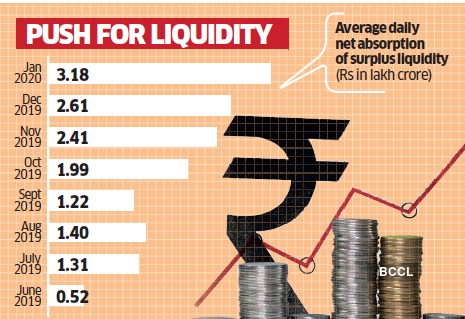[ad_1]
Banks have been keeping their surpluses with the RBI for the past eight months as they haven’t been able to push credit growth. The central bank may have paid them Rs 8,000-10,000 crore in the past few months, calculations by traders show. Some market participants peg this a little higher as variable reverse repos offer a few basis points extra.
In December and January, the average daily absorption under the Liquidity Adjustment Facility (LAF) amounted to Rs 2.61 lakh crore and Rs 3.18 lakh crore, respectively. In October and November, it was Rs 2.41 lakh crore and Rs 1.99 lakh crore, respectively.
“What RBI is spending on paying reverse repo interest could have added to dividend payout to the government,” said Soumyajit Niyogi, associate director at India Ratings & Research. “The surplus liquidity reflect that banks are not finding enough credit opportunities.”
The central bank shifted to easy liquidity position in the middle of last year as its interest rate reductions weren’t translating into lower borrowing costs. The bank, which for long believed in liquidity deficit for rate transmission, shifted to neutral in 2016, then to accommodative in June.
“Majority of banks were parking themselves on RBI LAF and asking for surplus money via reverse repos (both term and daily) as they wanted to play safe in absence of taking any new credit calls,” said Madan Sabnavis, chief economist at CARE Ratings. “A few banks, especially the large ones with lower deposit costs, may have tapped arbitrage between reverse repos and deposits.”
To be sure, the RBI is determined to help revive the economy and lower interest rates thanks to greater liquidity will help drive investment and consumption.
“RBI’s intention is to reduce the cost of money and achieve transmission by maintaining surplus liquidity in the system,” said Ritesh Bhusari, deputy general manager, treasury, South Indian Bank. “Daily money market operations are a part of that.
BCCL – Non Copyright

Banks are playing safe as they did not find other suitable credit opportunities and parking the surplus in reverse repo.”
A part of the costs could be offset through other liquidity operations.
“Such interest outgo could be netted off when it buys high-yielding papers via long term repos or OMOs (open market operatons),” said A Balasubramanian, CEO, Aditya Birla Sun Life MF. “Also, there are forex reserves. Overall dividend money would not be impacted but additional gains may have to be done away with partially.”
In August 2019, RBI approved a record Rs 1.76 lakh crore payout to the government, which is more than double the Rs 68,000 crore that it gave the previous year. This also included Rs 52,640 crore from its surplus capital.
There’s speculation that the government might seek an additional Rs 30,000 crore dividend from the government to plug the fiscal deficit or cover the excess of expenditure over revenue, traders said.
[ad_2]
Source link

